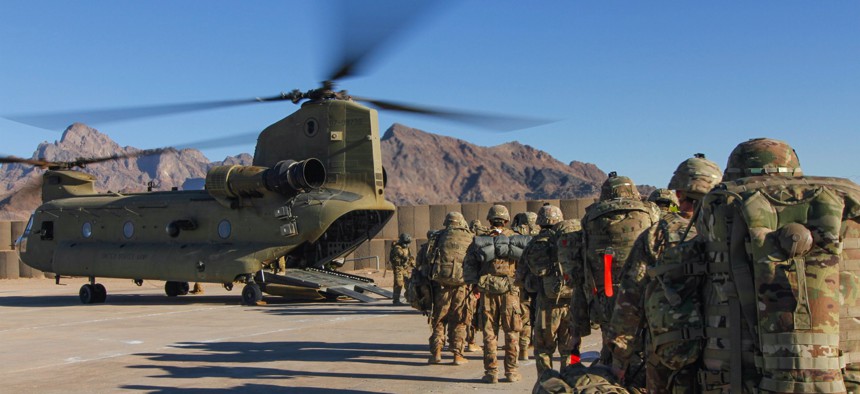
Iowa National Guard and 10th Mountain Division troops load onto a Chinook helicopter to head out and execute missions across the Combined Joint Operations Area-Afghanistan in January 2019. U.S. Army
The NDAA Should Prompt a Rethinking of Costly U.S. Foreign Policy
The annual defense authorization bill offers a chance to end wars and programs that are not worth their price.
Every year, members of the congressional armed services committees go through the long and sometimes torturous journey of assembling the National Defense Authorization Act, the annual bill that sets policy for the Defense Department. The entire process, however, is also a critical exercise in the formation of U.S. national security policy.
The defense policy bill is so valuable to Pentagon operations that lawmakers frequently refer to it as a must-pass piece of legislation. Ideally, the NDAA debate forces lawmakers to explain why certain military investments are necessary or why a particular overseas military engagement has outlived its usefulness.
Both the House and the Senate had a golden opportunity last week to finally terminate Washington’s involvement in Afghanistan’s civil war—the longest armed conflict in America’s 244-year history. Sen. Rand Paul forced a roll-call vote on an amendment to the Senate’s version of the NDAA that would have withdrawn the approximately 8,000-strong U.S. troop presence in Afghanistan over a period of 12 months.
Paul’s proposal also would have rescinded the 18-year old Authorization for Use of Military Force (AUMF), whose statutory interpretation has stretched to such farcical heights that virtually any kinetic action against a terrorist group is considered covered. That these provisions had to be introduced at all is a reflection of the absurdity of a war that, if the American people had anything to say about it, would have been over years ago. Unfortunately, the Senate killed the proposal by a 60-33 margin, preferring to keep this fruitless endeavor going.
Relatedly, the House Armed Services Committee outright prohibited the use of funds to cut the U.S. military presence in Afghanistan below 8,000 unless the administration submits a series of counterterrorism certifications that are impossible for any nation to meet. The 8,000-number was chosen for a very specific reason: to handicap President Trump’s ability to fulfill his promise of ending wars that drain the U.S. treasury and prevent the United States from refocusing on arguably higher strategic priorities in Asia.
Thankfully, there is still time for lawmakers to take a serious look at the current state of Washington’s national security policy.
One of the principal reasons the U.S. defense budget is so high—the White House’s FY21 budget request is $740.5 billion, more than the next 10 countries combined—is because U.S. policymakers simply ask U.S. troops to do too much in far too many places.
Tens of thousands of U.S. troops continue to be based in free and prosperous Europe. While some European allies are just now beginning to move in the direction of additional defense spending, the U.S. still encompasses nearly 70 percent of NATO’s total military expenditures. This ratio is unsustainable at a time when the U.S. is facing record U.S. deficits, a $26 trillion national debt, and a global environment in which the center of gravity is rapidly shifting to the Asia-Pacific. The U.S. military posture in Europe is a legacy of the Cold War and serves as a convenient justification for European nations to shortchange their own militaries. Reallocating U.S. forces from Europe would match Washington's actions on NATO burden-sharing coincide with its rhetoric.
As of March 2020, about 80,000 U.S. military personnel remain in the Middle East—a region plagued with internal turmoil, civil wars, localized insurgencies, corrupt and incompetent governance, and nations eager to exploit security ties with Washington for their own advantage. With the exception of preventing a regional hegemon—an ambition no nation in the region has the strength, financial resources, or will to achieve—and protecting the American people from anti-U.S. terrorists, U.S. interests in the Middle East are incredibly limited. Washington should transition from a strategy of forward-deployment to one of off-shore balancing, decreasing the risk U.S. troops will be swept up in the region’s rivalries while preserving the flexibility to respond in the event a direct threat is spotted.
One of the easiest ways to cut unnecessary burdens in the Middle East is to extricate the U.S. from the war in Yemen, which the UN has called the largest man-made humanitarian catastrophe in the world. The violence is considerably worse due to U.S. logistical, intelligence, and fuel-support to Saudi Arabia, all of which is unauthorized by Congress. Severing aid to the Saudi-led coalition would separate the U.S. from a conflict it should never have been involved in.
Yemen is hardly the only place in the Middle East where Washington should cut bait. In Syria, years of U.S.-led military bombardment have significantly downgraded the Islamic State’s power. Regional stakeholders have both the capacity and incentive to manage the threat. Hundreds of U.S. troops, however, remain on Syrian soil, tasked with guarding small oil fields at considerable risk to their physical safety. Putting continuous pressure on the Assad regime and combating Iranian influence in Syria is wholly detached from the original objective of destroying ISIS’s physical caliphate—an objective the U.S. and its partners accomplished with the capture of Baghouz, Syria, 16 months ago.
With a $21.4 trillion GDP and a military that is second to none, the United States continues to be a world power. Yet even the U.S. must resist the temptation of hubris driving the policymaking process.
Difficult but necessary decisions about U.S. priorities need to be made. Future military deployments need to be heavily scrutinized. And assumptions that have powered the U.S. foreign policy community for decades need to be challenged—and when appropriate, discarded.
NEXT STORY: Build a National Counter-Drone Network



